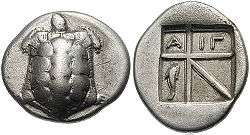Coin
| Numismatics |
|---|
.png) |
| Currency |
| Circulating currencies |
|
| Local currencies |
| Fictional currencies |
| History |
| Historical currencies |
| Byzantine |
| Medieval currencies |
| Production |
| Exonumia |
| Notaphily |
| Scripophily |
|

A coin is a small, flat, round piece of metal or plastic used primarily as a medium of exchange or legal tender. They are standardized in weight, and produced in large quantities at a mint in order to facilitate trade. They are most often issued by a government.
Coins are usually metal or alloy, or sometimes made of synthetic materials. They are usually disc shaped. Coins made of valuable metal are stored in large quantities as bullion coins. Other coins are used as money in everyday transactions, circulating alongside banknotes. Usually the highest value coin in circulation (i.e. excluding bullion coins) is worth less than the lowest-value note. In the last hundred years, the face value of circulation coins has occasionally been lower than the value of the metal they contain, for example due to inflation. If the difference becomes significant, the issuing authority may decide to withdraw these coins from circulation, possibly issuing new equivalents with a different composition, or the public may decide to melt the coins down or hoard them (see Gresham's law).
Exceptions to the rule of face value being higher than content value also occur for some bullion coins made of copper, silver, or gold (and, rarely, other metals, such as platinum or palladium), intended for collectors or investors in precious metals. Examples of modern gold collector/investor coins include the British sovereign minted by the United Kingdom, the American Gold Eagle minted by the United States, the Canadian Gold Maple Leaf minted by Canada, and the Krugerrand, minted by South Africa. While the Eagle, Maple Leaf, and Sovereign coins have nominal (purely symbolic) face values; the Krugerrand does not.
Historically, a great quantity of coinage metals (including alloys) and other materials (e.g. porcelain) have been used to produce coins for circulation, collection, and metal investment: bullion coins often serve as more convenient stores of assured metal quantity and purity than other bullion.[1]
History
The first coins were developed independently in Iron Age Anatolia and Archaic Greece, India and China around the 7th and 6th centuries BCE. Coins spread rapidly in the 6th and 5th centuries BCE, throughout Greece and Persia, and further to the Balkans.[2]
Standardized Roman currency was used throughout the Roman Empire. Important Roman gold and silver coins were continued into the Middle Ages (see Gold dinar, Solidus, Aureus, Denarius). Ancient and early medieval coins in theory had the value of their metal content, although there have been many instances throughout history of the metal content of coins being debased, so that the inferior coins were worth less in metal than their face value. Fiat money first arose in medieval China, with the jiaozi paper money. Early paper money was introduced in Europe in the later Middle Ages, but some coins continued to have the value of the gold or silver they contained throughout the Early Modern period. The penny was minted as a silver coin until the 17th century.
The first circulating United States coins were cents (pennies), produced in 1793, and made entirely from copper.[3] Silver content was reduced in many coins in the 19th century (use of billon), and the first coins made entirely of base metal (e.g. nickel, cupronickel, aluminium bronze), representing values higher than the value of their metal, were minted in the mid 19th century.
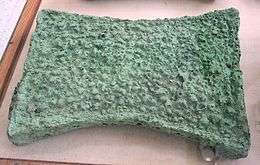
Coins were an evolution of "currency" systems of the Late Bronze Age, where standard-sized ingots, and tokens such as knife money, were used to store and transfer value. In the late Chinese Bronze Age, standardized cast tokens were made, such as those discovered in a tomb near Anyang.[4][5] These were replicas in bronze of earlier Chinese currency, cowrie shells, so they were named Bronze Shell.[6]
Iron Age
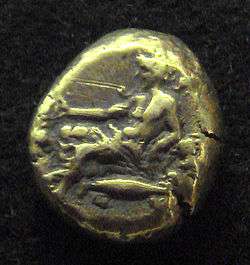
According to Aristotle (fr. 611,37,ed. V. Rose) and Pollux (Onamastikon IX.83), the first issuer of coins was Hermodike of Kyme[8]
The earliest coins are mostly associated with Iron Age Anatolia, especially with the kingdom of Lydia.[9] Early electrum coins were not standardized in weight, and in their earliest stage may have been ritual objects, such as badges or medals, issued by priests.[10] Many early Lydian and Greek coins were minted under the authority of private individuals and are thus more akin to tokens or badges than to modern coins,[11] though due to their numbers it is evident that some were official state issues, with King Alyattes of Lydia being a frequently mentioned originator of coinage.[12]
The first Lydian coins were made of electrum, a naturally occurring alloy of silver and gold that was further alloyed with added silver and copper.[13] Most of the early Lydian coins include no writing ("legend" or "inscription"), only an image of a symbolic animal. Therefore, the dating of these coins relies primarily on archaeological evidence, with the most commonly cited evidence coming from excavations at the Temple of Artemis at Ephesus, also called the Ephesian Artemision (which would later evolve into one of the Seven Wonders of the Ancient World). Because the oldest lion head "coins" were discovered in that temple, and they do not appear to have been used in commerce, these objects may not have been coins but badges or medals issued by the priests of that temple. Anatolian Artemis was the Πὀτνια Θηρῶν (Potnia Thêrôn, "Mistress of Animals"), whose symbol was the stag.
A small percentage of early Lydian/Greek coins have a legend.[14] A famous early electrum coin, the most ancient inscribed coin at present known, is from nearby Caria. This coin has a Greek legend reading phaenos emi sema[15] interpreted variously as "I am the badge of Phanes", or "I am the sign of light",[16] or "I am the tomb of light", or "I am the tomb of Phanes". The coins of Phanes are known to be amongst the earliest of Greek coins, a hemihekte of the issue was found in the foundation deposit of the temple of Artemis at Ephesos (the oldest deposit of electrum coins discovered). One assumption is that Phanes was a wealthy merchant, another that this coin is associated with Apollo-Phanes and, due to the Deer, with Artemis (twin sister of the god of light Apollo-Phaneos). Although only seven Phanes type coins were discovered, it is also notable that 20% of all early electrum coins also have the lion of Artemis and the sun burst of Apollo-Phaneos.
Alternatively, Phanes may have been the Halicarnassian mercenary of Amasis mentioned by Herodotus, who escaped to the court of Cambyses, and became his guide in the invasion of Egypt in 527 or 525 BCE. According to Herodotus, this Phanes was buried alive by a sandstorm, together with 50,000 Persian soldiers, while trying to conquer the temple of Amun–Zeus in Egypt.[17] The fact that the Greek word "Phanes" also means light (or lamp), and the word "sema" also means tomb makes this coin a famous and controversial one.[18]
Another candidate for the site of the earliest coins is Aegina, where Chelone ("turtle") coins were first minted on 700 BCE,[19] either by the local Aegina people or by Pheidon king of Argos (who first set the standards of weights and measures). In the Bibliothèque Nationale, Paris, there is a unique electrum stater of Aegina.[7][20]
Coins from Athens and Corinth appeared shortly thereafter, known to exist at least since the late 6th century BCE.[21]
Classical antiquity

Coinage followed Greek colonization and influence first around the Mediterranean and soon after to North Africa (including Egypt), Syria, Persia, and the Balkans.[22]
Coins were minted in the Achaemenid Empire, including the gold darics and silver sigloi. With the Achemenid conquest of Gandhara under Darius the Great c. 520 BCE, the practice spread to the Indo-Gangetic Plain. The coins of this period were called Puranas, Karshapanas or Pana.[23] These earliest Indian coins, however, are unlike those circulated in Persia, which were derived from the Greek/Anatolian type; they not disk-shaped but rather stamped bars of metal, suggesting that the innovation of stamped currency was added to a pre-existing form of token currency which had already been present in the Mahajanapada kingdoms of the Indian Iron Age. Mahajanapadas that minted their own coins included Gandhara, Kuntala, Kuru, Panchala, Shakya, Surasena and Surashtra.[24]
In China, early round coins appeared in the 4th century BCE.
The first Roman coins, which were crude, heavy cast bronzes, were issued c. 289 BCE.[25]
 Persian Achaemenid Daric, c. 350 BCE
Persian Achaemenid Daric, c. 350 BCE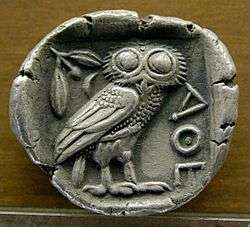 Reverse of a silver Tetradrachm from Athens, c. 480-420 BCE
Reverse of a silver Tetradrachm from Athens, c. 480-420 BCE- Bronze coin issued by Antiochus IV Epiphanes, 2nd century BCE. Coin edges are curled to prevent swindlers from stealing metal by scraping the edges.
._Bilingual_series._BASILEWS_AGAQOKLEOUS_with_Indian_god_Balarama-Samkarshana.jpg) Bactrian Drachm minted c. 185-170 BCE
Bactrian Drachm minted c. 185-170 BCE A bronze coin of the Chinese Han Dynasty, c. 1st century BCE
A bronze coin of the Chinese Han Dynasty, c. 1st century BCE Sestertius of Marcus Clodius Pupienus Maximus, 238 CE
Sestertius of Marcus Clodius Pupienus Maximus, 238 CE
Middle Ages
The first European coin to use Arabic numerals to date the year in which the coin was minted was the St. Gall silver Plappart of 1424.[27]

 Silver Dirham of the Umayyad Caliphate, 729 CE
Silver Dirham of the Umayyad Caliphate, 729 CE Abbasid coin, c. 1080s CE
Abbasid coin, c. 1080s CE Almoravid coin, 1138-39 CE
Almoravid coin, 1138-39 CE
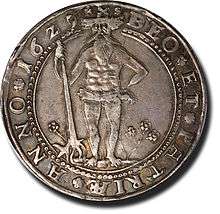 Brunswick-Wolfenbüttel Thaler minted in 1629
Brunswick-Wolfenbüttel Thaler minted in 1629 Japanese local currency Genbun Inari Koban Kin, c. 1736–1741
Japanese local currency Genbun Inari Koban Kin, c. 1736–1741 1768 silver Spanish Dollar, or eight reales coin (the “piece of eight” of pirate fame), minted throughout the Spanish Empire
1768 silver Spanish Dollar, or eight reales coin (the “piece of eight” of pirate fame), minted throughout the Spanish Empire Ottoman coin, 1818
Ottoman coin, 1818- One Rupee coin issued by the East India Company, 1835
Value

 |
| An unusual copper coin of King George IV of Georgia with Georgian inscriptions, 1210 CE |
Currency
Most coins presently are made of a base metal, and their value comes from their status as fiat money. This means that the value of the coin is decreed by government fiat (law), and thus is determined by the free market only in as much as national currencies are used in domestic trade and also traded internationally on foreign exchange markets. Thus, these coins are monetary tokens, just as paper currency is: they are usually not backed by metal, but rather by some form of government guarantee. Some have suggested that such coins not be considered to be "true coins" (see below). Thus, there is very little economic difference between notes and coins of equivalent face value.
Coins may be in circulation with fiat values lower than the value of their component metals, but they are never initially issued with such value, and the shortfall only arises over time due to inflation, as market values for the metal overtake the fiat declared face value of the coin. Examples are the pre-1965 US dime, quarter, half dollar, and dollar (nominally containing slightly less than a tenth, quarter, half, and full ounce of silver, respectively), US nickel, and pre-1982 US penny. As a result of the increase in the value of copper, the United States greatly reduced the amount of copper in each penny. Since mid-1982, United States pennies are made of 97.5% zinc, with the remaining 2.5% being a coating of copper. Extreme differences between fiat values and metal values of coins cause coins to be hoarded or removed from circulation by illicit smelters in order to realise the value of their metal content. This is an example of Gresham's law. The United States Mint, in an attempt to avoid this, implemented new interim rules on December 14, 2006, subject to public comment for 30 days, which criminalized the melting and export of pennies and nickels.[28] Violators can be fined up to $10,000 and/or imprisoned for up to five years.
Collector's item
A coin's value as a collector's item or as an investment generally depends on its condition, specific historical significance, rarity, quality, beauty of the design and general popularity with collectors. If a coin is greatly lacking in all of these, it is unlikely to be worth much. The value of bullion coins is also influenced to some extent by those factors, but is largely based on the value of their gold, silver, or platinum content. Sometimes non-monetized bullion coins such as the Canadian Maple Leaf and the American Gold Eagle are minted with nominal face values less than the value of the metal in them, but as such coins are never intended for circulation, these face values have no relevance.
Medium of expression
Coins can be used as creative medium of expression – from fine art sculpture to the penny machines that can be found in most amusement parks. In the Code of Federal Regulations (CFR) in the United States there are some regulations specific to nickels and pennies that are informative on this topic. 31 CFR § 82.1 forbids unauthorized persons from exporting, melting, or treating any 5 or 1 cent coins.
This has been a particular problem with nickels and dimes (and with some comparable coins in other currencies) because of their relatively low face value and unstable commodity prices. For a while the copper in US pennies was worth more than one cent, so people would hoard pennies and then melt them down for their metal value. It cost more than face value to manufacture pennies or nickels, so any widespread loss of the coins in circulation could be expensive for the US Treasury. This was more of a problem when coins were still made of precious metals like silver and gold, so strict laws against alteration make more sense historically.
31 CFR § 82.2 goes on to state that: "(b) The prohibition contained in § 82.1 against the treatment of 5-cent coins and one-cent coins shall not apply to the treatment of these coins for educational, amusement, novelty, jewelry, and similar purposes as long as the volumes treated and the nature of the treatment makes it clear that such treatment is not intended as a means by which to profit solely from the value of the metal content of the coins."
Debasement
Throughout history, monarchs and governments have often created more coinage than their supply of precious metals would allow if the coins were pure metal. By replacing some fraction of a coin's precious metal content with a base metal (often copper or nickel), the intrinsic value of each individual coin was reduced (thereby "debasing" the money), allowing the coining authority to produce more coins than would otherwise be possible. Debasement occasionally occurs in order to make the coin physically harder and therefore less likely to be worn down as quickly, but the more usual reason is to profit from the difference between face value and metal value. Debasement of money almost always leads to price inflation. Sometimes price controls are at the same time also instituted by the governing authority, but historically these have generally proved unworkable.
The United States is unusual in that it has only slightly modified its coinage system (except for the images and symbols on the coins, which have changed a number of times) to accommodate two centuries of inflation. The one-cent coin has changed little since 1856 (though its composition was changed in 1982 to remove virtually all copper from the coin) and still remains in circulation, despite a greatly reduced purchasing power. On the other end of the spectrum, the largest coin in common circulation is valued at 25 cents, a very low value for the largest denomination coin compared to many other countries. Increases in the prices of copper, nickel, and zinc meant that both the US one- and five-cent coins became worth more for their raw metal content than their face (fiat) value. In particular, copper one-cent pieces (those dated prior to 1982 and some 1982-dated coins) contained about two cents' worth of copper.
Some denominations of circulating coins that were formerly minted in the United States are no longer made. These include coins with a face value of a half cent, two cents, three cents, and twenty cents. (The half dollar and dollar coins are still produced, but mostly for vending machines and collectors.) In the past, the US also coined the following denominations for circulation in gold: One dollar, $2.50, three dollars, five dollars, ten dollars, and twenty dollars. In addition, cents were originally slightly larger than the modern quarter and weighed nearly half an ounce, while five-cent coins (known then as "half dimes") were smaller than a dime and made of a silver alloy. Dollar coins were also much larger, and weighed approximately an ounce. One-dollar gold coins are no longer produced and rarely used. The US also issues bullion and commemorative coins with the following denominations: 50¢, $1, $5, $10, $25, $50, and $100.
Other uses
Some convicted criminals from the British Isles who were sentenced to transportation to Australia in the 18th and 19th centuries used coins to leave messages of remembrance to loved ones left behind in Britain. The coins were defaced, smoothed and inscribed, either by stippling or engraving, with sometimes touching words of loss. These coins were called "convict love tokens" or "leaden hearts".[29] A number of these tokens are in the collection of the National Museum of Australia.
Features of modern coins
.jpg)

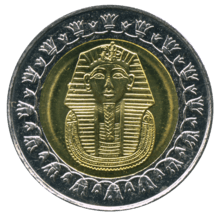
Circulating coins commonly suffered from "shaving" or "clipping": the public would cut off small amounts of precious metal from their edges to sell it and then pass on the mutilated coins at full value.[30] Unmilled British sterling silver coins were sometimes reduced to almost half their minted weight. This form of debasement in Tudor England was commented on by Sir Thomas Gresham, whose name was later attached to Gresham's law. The monarch would have to periodically recall circulating coins, paying only the bullion value of the silver, and reminting them. This, also known as recoinage, is a long and difficult process that was done only occasionally.[31] Many coins have milled or reeded edges, originally designed to make it easier to detect clipping.
The side of a coin carrying an image of a monarch or other authority, or a national emblem, is usually called the obverse, or colloquially, heads; see also List of people on coins. The other side, which may carry the denomination, is usually called the reverse, or colloquially, tails. The year of minting is usually shown on the obverse, although some Chinese coins, most Canadian coins, the pre-2008 British 20p coin, and all Japanese coins, are exceptions.
In cases where a correctly oriented coin is flipped about its horizontal axis to show the other side correctly oriented, the coin is said to have coin orientation. In cases where a coin is flipped about its vertical axis to show the other side correctly oriented, it is said to have medallic orientation. While coins of the United States dollar display coin orientation, those of the Euro and pound sterling have medallic orientation.
Bimetallic coins are sometimes used for higher values and for commemorative purposes. In the 1990s, France used a tri-metallic coin. Common circulating bimetallic examples include the €1, €2, British £2 and Canadian $2 and several Peso coins in Mexico.
The exergue is the space on a coin beneath the main design, often used to show the coin's date, although it is sometimes left blank or containing a mint mark, privy mark, or some other decorative or informative design feature. Many coins do not have an exergue at all, especially those with few or no legends, such as the Victorian bun penny.

Not all coins are round. The Australian 50 cent coin, for example, has twelve flat sides. Some coins have wavy edges, e.g. the $2 and 20-cent coins of Hong Kong and the 10 cent coins of Bahamas. Some are square-shaped, such as the 15 cent coin of the Bahamas. During the 1970s, Swazi coins were minted in several shapes, including squares, polygons, and wavy edged circles with 8 and 12 waves.
 scalloped coin of Israel
scalloped coin of Israel 1996 one cent coin from Belize
1996 one cent coin from Belize 2005 Bahamas 15 cent coin is square with rounded corners
2005 Bahamas 15 cent coin is square with rounded corners Decagonal two Piso Philippine coin 1990
Decagonal two Piso Philippine coin 1990
Some other coins, like the British 20 and 50 pence coins and the Canadian Loonie, have an odd number of sides, with the edges rounded off. This way the coin has a constant diameter, recognisable by vending machines whichever direction it is inserted.
A triangular coin with a face value of £5 (produced to commemorate the 2007/2008 Tutankhamun exhibition at The O2 Arena) was commissioned by the Isle of Man: it became legal tender on 6 December 2007.[32] Other triangular coins issued earlier include: Cabinda coin, Bermuda coin, 2 Dollar Cook Islands 1992 triangular coin, Uganda Millennium Coin and Polish Sterling-Silver 10-Zloty Coin.
Some mediaeval coins, called bracteates, were so thin they were struck on only one side.
Many coins over the years have been manufactured with integrated holes such as Chinese "cash" coins, Japanese coins, Colonial French coins, etc. This may have been done to permit their being strung on cords, to facilitate storage and being carried, etc.
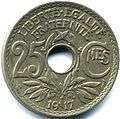 1917 French coin with integrated hole
1917 French coin with integrated hole- Chinese Cash coin
 1941 Palestine coin
1941 Palestine coin Japanese 5 Yen coin
Japanese 5 Yen coin 1924 East African coin
1924 East African coin
The Royal Canadian Mint is now able to produce holographic-effect gold and silver coinage. However, this procedure is not limited to only bullion or commemorative coinage. The 500 yen coin from Japan was subject to a massive amount of counterfeiting. The Japanese government in response produced a circulatory coin with a holographic image.
The Royal Canadian Mint has also released several coins that are coloured, the first of which was in commemoration of Remembrance Day. The subject was a coloured poppy on the reverse of a 25 cent piece.
An example of non-metallic composite coins (sometimes incorrectly called plastic coins) was introduced into circulation in Transnistria on 22 August 2014. Most of these coins are also non-circular, with different shapes corresponding to different coin values.[34]
For a list of many pure metallic elements and their alloys which have been used in actual circulation coins and for trial experiments, see coinage metals.[35]
Physics and chemistry
Flipping
Coins are popularly used as a sort of two-sided dice; in order to choose between two options with a random possibility, one choice will be labeled heads and the other tails, and a coin will be flipped or tossed to see whether the heads or tails side comes up on top – see coin flipping. Mathematically, this is known as a Bernoulli trial: a fair coin is defined to have the probability of heads (in the parlance of Bernoulli trials, a "success") of exactly 0.5.
Spinning
Coins can also be spun on a flat surface such as a table. This results in the following phenomenon: as the coin falls over and rolls on its edge, it spins faster and faster (formally, the precession rate of the symmetry axis of the coin, i.e., the axis passing from one face of the coin to the other) before coming to an abrupt stop. This is mathematically modeled as a finite-time singularity – the precession rate is accelerating to infinity, before it suddenly stops, and has been studied using high speed photography and devices such as Euler's Disk. The slowing down is predominantly caused by rolling friction (air resistance is minor), and the singularity (divergence of the precession rate) can be modeled as a power law with exponent approximately −1/3.[36]
Odor
Iron and copper coins have a characteristic metallic smell that is produced upon contact with oils in the skin. Perspiration is chemically reduced upon contact with these metals, which causes the skin oils to decompose, forming with iron the volatile molecule 1-octen-2-one.[37]
See also
Notes and references
- ↑ Tony Clayton. "Comprehensive list of metals and their alloys which have been used at various times, in coins for all types of purposes". Tclayton.demon.co.uk. Retrieved 2012-05-21.
- ↑ "Cent". Retrieved 7 March 2015.
- ↑ "Timeline of the United States Mint". US Mint website. US Department of the Treasury. Retrieved 14 October 2016.
1793 - The first coins struck are 'half dimes', believed to be made from silverware provided by George and Martha Washington. The first circulating coins are copper cents.
- ↑ "中國最早金屬鑄幣 商代晚期鑄造銅貝-河南概況". Big5.henan.gov.cn. Retrieved 2012-05-22.
- ↑ Giedroyc, Richard (2006-11-15). The Everything Coin Collecting Book: All You Need to Start Your Collection ... Books.google.com. Retrieved 2012-05-21.
- ↑ YK Kwan. "A snap shot view of The history of China by YK Kwan". Chinesechinese.net. Archived from the original on 2012-05-03. Retrieved 2012-05-21.
- 1 2 Attica XXIII image
- ↑ https://books.google.gr/books?id=5AOw0GB0zHsC&pg=PA705&lpg=PA705&dq=demodike+of+kyme&source=bl&ots=jijVqB_7EZ&sig=zQAkTk1jE8FGbmBTRBh50uwjGmI&hl=el&sa=X&ved=0ahUKEwjlwYvpxt3JAhWL2BoKHccqBhUQ6AEILzAC#v=onepage&q=demodike of kyme
- ↑ M. Kroll, review of G. Le Rider's La naissance de la monnaie, Schweizerische Numismatische Rundschau 80 (2001), p. 526. D. Sear, Greek Coins and Their Values Vol. 2, Seaby, London, 1979, p. 317.
- ↑ "The Types of Greek Coins" An Archaeological Essay by Percy Gardner 1883 p.42 "Considering these and other facts it may be held to be probable, if not absolutely proved, that priests first issued stamped coin, and that the first mints were in Greek temples."
- ↑ G. Hanfmann, pp. 73, 77. R. Seaford, p. 128, points out, "The nearly total lack of … coins in the excavated commercial-industrial areas of Sardis suggests that they were concentrated in the hands of the king and possibly wealthy merchants."
- ↑ A. Ramage, "Golden Sardis", King Croesus' Gold: Excavations at Sardis and the History of Gold Refining, edited by A. Ramage and P. Craddock, Harvard University Press, Cambridge, 2000, p. 18.
- ↑ "A Case for the World's Oldest Coin: Lydian Lion". Rg.ancients.info. 2003-10-02. Retrieved 2013-10-23.
- ↑ "Inscriptions and Titles on ancient Greek coins". Snible.org. Retrieved 2012-05-21.
- ↑ "Electrum stater inscribed with the name of Phanes". British Museum. 2011-09-29. Retrieved 2012-05-21.
- ↑ Newton Num. Chron., 1870, p. 238
- ↑ "Full text of "The numismatic chronicle and journal of the Royal Numismatic Society"". Archive.org. Retrieved 2012-05-21.. Herodotus third book (ch. iv.).
- ↑ "Ancient coinage of Ionia". Snible.org. Retrieved 2012-05-21.
- ↑ British Museum Catalogue 11 - Attica Megaris Aegina, 700 - 550 BCE, plate XXIII.
- ↑ "Ancient coinage of Aegina". Snible.org. Retrieved 2012-05-21.
- ↑ C. Kraay, Archaic and Classical Greek Coins, University of California Press, Berkeley, 1976.
- ↑ Howgego, C. J. (1995). Ancient history from coins. Psychology Press. pp. 1–4. ISBN 978-0-415-08993-7. Retrieved 4 December 2011.
- ↑ See P.L. Gupta: Coins, New Delhi, National Book Trust, 1996, Chapter II.
- ↑ "The COININDIA Coin Galleries: Gandhara Janapada". Coinindia.com. Retrieved 2012-05-22. "The COININDIA Coin Galleries: Kuntala Janapada". Coinindia.com. Retrieved 2012-05-22. "The COININDIA Coin Galleries: Kuru Janapada". Coinindia.com. Retrieved 2012-05-22. "The COININDIA Coin Galleries: Panchala Janapada". Coinindia.com. Retrieved 2012-05-22. "The COININDIA Coin Galleries: Shakya Janapada". Coinindia.com. Retrieved 2012-05-22. "The COININDIA Coin Galleries: Shurasena Janapada". Coinindia.com. Retrieved 2012-05-22. "The COININDIA Coin Galleries: Surashtra Janapada". Coinindia.com. Retrieved 2012-05-22.
- ↑ W. Sayles, Ancient Coin Collecting III: The Roman World–Politics and Propaganda, Krause Publications, Iola, Wisconsin, 1997
- ↑ "The Janapada Coins". Retrieved 2013-08-10.
- ↑ Early Dated Coins, http://www.medievalcoinage.com/earlydated, Accessed December 2009.
- ↑ "United States Mint Moves to Limit Exportation & Melting of Coins". The United States Mint. Retrieved 2012-05-22.
- ↑ "Convict tokens, National Museum of Australia". Nma.gov.au. 2012-01-25.
- ↑ Cooper, George (2008). The Origin of Financial Crises. New York: Random House. p. 46. ISBN 978-0-307-47345-5.
- ↑ Denis R. Cooper The Art and Craft of Coinmaking. A History of Minting Technology. London: Spink, 1988. ISBN 0-907605-27-3 p.47
- ↑ It is unlikely to be spent as it costs 15GBP to buy – article Pyramid coin a nightmare for pockets, article by Gary
- ↑ "most expensive currencies of the world". 2007-09-12. Archived from the original on 28 April 2012. Retrieved 2012-05-22.
- ↑ "Composite coins".
- ↑ Tony Clayton. "Metals Used in Coins and Medals". Tclayton.demon.co.uk. Retrieved 2012-05-22.
- ↑ Easwar, K.; Rouyer, F.; Menon, N. (2002). "Speeding to a stop: The finite-time singularity of a spinning disk". Physical Review E. 66 (4). Bibcode:2002PhRvE..66d5102E. doi:10.1103/PhysRevE.66.045102.
- ↑ A 'metallic' smell is just body odour
Bibliography
- Angus, Ian. Coins & Money Tokens. London: Ward Lock, 1973. ISBN 0-7063-1811-0.
External links
-
 Media related to Coins at Wikimedia Commons
Media related to Coins at Wikimedia Commons



